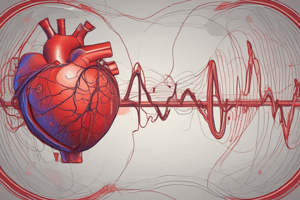Podcast
Questions and Answers
What occurs during the diastole phase of the cardiac cycle?
What occurs during the diastole phase of the cardiac cycle?
- The heart is relaxed and fills with blood. (correct)
- The ventricles contract, pumping blood out of the heart.
- The atria contract, pumping blood into the ventricles.
- The semilunar valves open, allowing blood to flow into pulmonary and aortic trunks.
Which valves are open during the atrial contraction phase?
Which valves are open during the atrial contraction phase?
- Aortic valves
- Pulmonary valves
- Atrioventricular (AV) valves (correct)
- Semilunar valves
What is the result of isovolumic contraction?
What is the result of isovolumic contraction?
- The semilunar valves open.
- Blood is ejected from the ventricles.
- The volume of blood in the ventricles decreases. (correct)
- The atrioventricular valves close.
What is the formula for cardiac output (CO)?
What is the formula for cardiac output (CO)?
What is the end-diastolic volume (EDV)?
What is the end-diastolic volume (EDV)?
During which phase of the cardiac cycle does blood pressure increase?
During which phase of the cardiac cycle does blood pressure increase?
Flashcards are hidden until you start studying
Study Notes
Phases of the Cardiac Cycle
Diastole
- The heart is relaxed and fills with blood
- Atrioventricular (AV) valves open, allowing blood to flow from atria to ventricles
- Semilunar valves closed, preventing backflow into pulmonary and aortic trunks
Atrial Contraction
- Atria contract, pumping blood into ventricles
- AV valves still open, allowing blood to flow into ventricles
- Semilunar valves remain closed
Ventricular Contraction (Systole)
- Ventricles contract, pumping blood out of the heart
- AV valves close, preventing backflow into atria
- Semilunar valves open, allowing blood to flow into pulmonary and aortic trunks
Isovolumic Contraction
- Ventricles contract, but semilunar valves remain closed
- Blood volume in ventricles decreases, but no blood is ejected
Rapid Ejection
- Semilunar valves open, allowing blood to flow out of ventricles and into pulmonary and aortic trunks
- Blood pressure increases
Reduced Ejection
- Blood flow out of ventricles slows down
- Blood pressure decreases
Isovolumic Relaxation
- Ventricles relax, and semilunar valves close
- Blood volume in ventricles increases, but no blood flows in
Other Key Concepts
- Stroke Volume (SV): volume of blood ejected per beat
- Cardiac Output (CO): total volume of blood pumped per minute (CO = SV x Heart Rate)
- End-Diastolic Volume (EDV): volume of blood in ventricles at end of diastole
- End-Systolic Volume (ESV): volume of blood in ventricles at end of systole
Phases of the Cardiac Cycle
Diastole
- Heart is relaxed and fills with blood
- Atrioventricular (AV) valves are open, allowing blood to flow from atria to ventricles
- Semilunar valves are closed, preventing backflow into pulmonary and aortic trunks
Atrial Contraction
- Atria contract, pumping blood into ventricles
- AV valves are still open, allowing blood to flow into ventricles
- Semilunar valves remain closed
Ventricular Contraction (Systole)
- Ventricles contract, pumping blood out of the heart
- AV valves are closed, preventing backflow into atria
- Semilunar valves are open, allowing blood to flow into pulmonary and aortic trunks
Isovolumic Contraction and Relaxation
- Ventricles contract, but semilunar valves remain closed, and blood volume in ventricles decreases
- Ventricles relax, and semilunar valves close, and blood volume in ventricles increases
Blood Flow and Pressure
- Blood flow out of ventricles increases, and blood pressure increases during rapid ejection
- Blood flow out of ventricles slows down, and blood pressure decreases during reduced ejection
Key Concepts
Cardiac Output and Stroke Volume
- Stroke Volume (SV) is the volume of blood ejected per beat
- Cardiac Output (CO) is the total volume of blood pumped per minute, calculated by CO = SV x Heart Rate
Ventricular Volumes
- End-Diastolic Volume (EDV) is the volume of blood in ventricles at the end of diastole
- End-Systolic Volume (ESV) is the volume of blood in ventricles at the end of systole
Studying That Suits You
Use AI to generate personalized quizzes and flashcards to suit your learning preferences.




